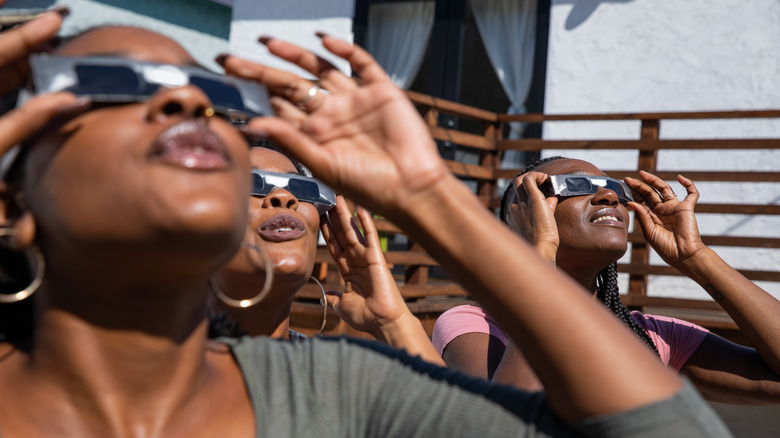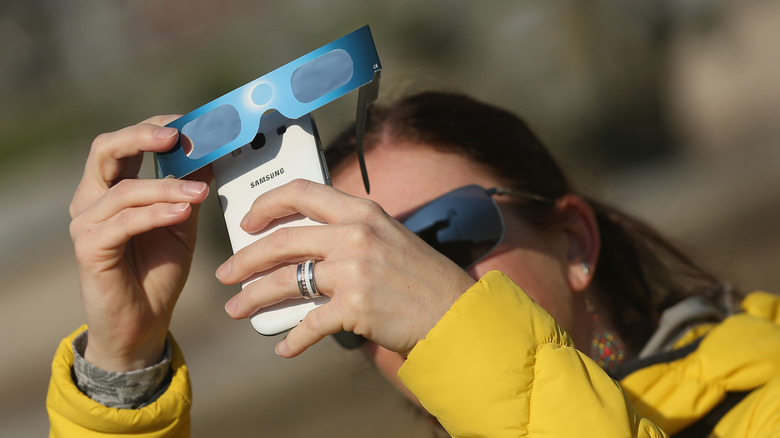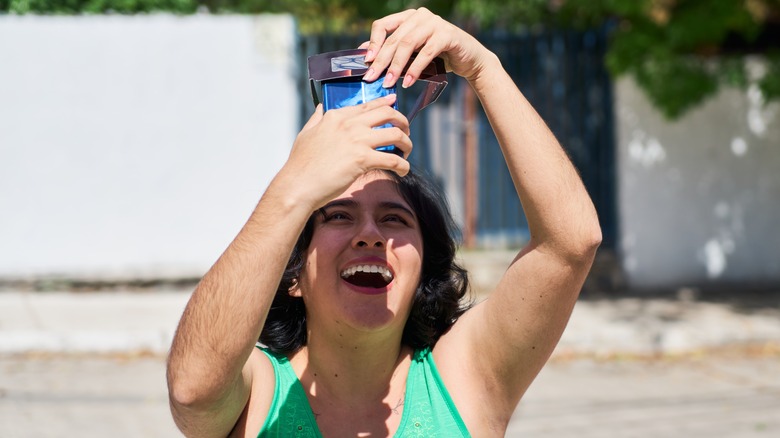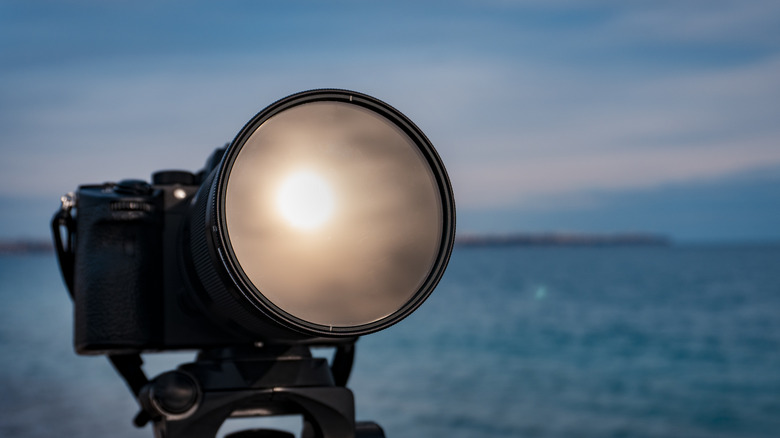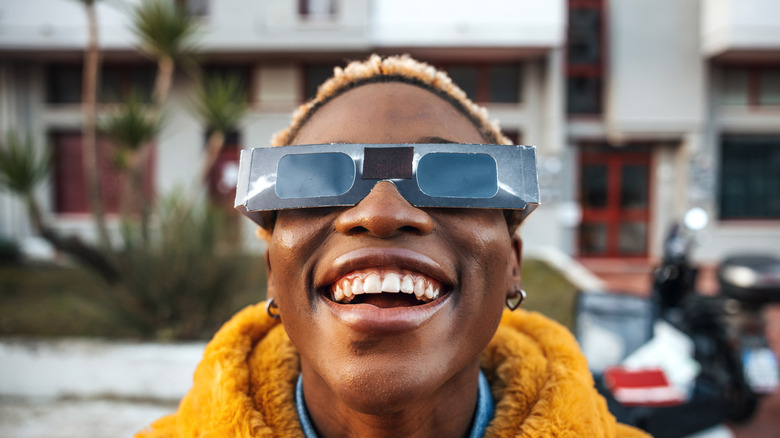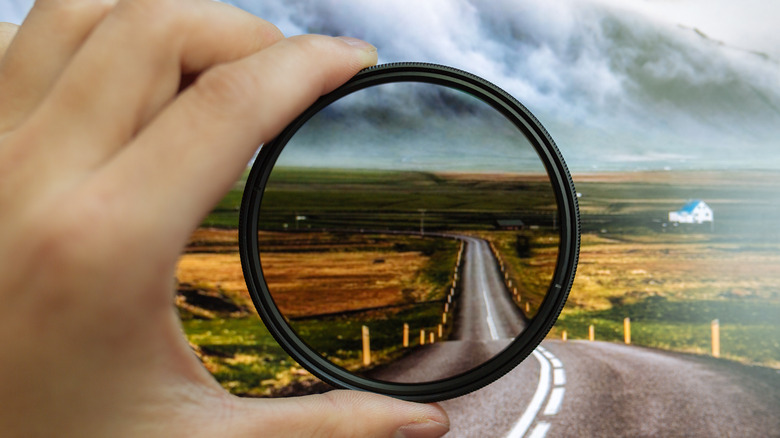This Year's Solar Eclipse Could Fry Your Phone: Here's How To Protect It
We may receive a commission on purchases made from links.
Humans have always been fascinated by solar eclipses. This phenomenon happens when the moon is at just the "right" distance from the Earth, letting it partially or completely block the sun. Solar eclipses could be broadly classified into partial, annular, hybrid, and total eclipses, of which total eclipses are widely thought to be visually most spectacular. At the same time, total solar eclipses tend to be extremely rare celestial events — so rare, in fact, the last time the continental United States witnessed a total solar eclipse was nearly seven years ago in August 2017.
The next total solar eclipse is set to take place on April 8, 2024. It will be the last total solar eclipse people in the continental United States will witness until August 2044, over 20 years from now. Thanks to its rarity, people across the U.S. are gearing up to witness the event in whatever way possible.
However, as beautiful as they are, it is a well-known fact that looking directly at the sun — including during an eclipse — can be very harmful to your eyes. Thanks to widespread information campaigns, even amateur eclipse watchers take several precautions to enjoy solar eclipses without damaging their eyesight. However, many will be looking to use their smartphones this year to click photos or take videos of the eclipse to commemorate it forever. This begs the question — how safe is it to point your smartphone at the sun during an eclipse?
Why it's risky to photograph a solar eclipse with your smartphone
Most discussions about solar eclipses damaging smartphones center around a document released by NASA on the eve of the last U.S. total solar eclipse in 2017. According to that document, it may be safe for smartphones with small sensors and slower lenses to capture images of a solar eclipse. These lenses also come with UV filters that do a decent job of filtering out some visible light and potentially reducing damage to the sensor.
However, smartphone lenses have gotten larger over the years, and given their ability to gather more light, NASA says that devices with larger or faster lenses could potentially damage sensors if they are used to capture pictures and videos of the solar eclipse. The agency's paper also discusses the possibility of people damaging their eyes if they accidentally look at the solar disk while pointing their smartphones toward the sun.
After the 2017 solar eclipse, Lens Rentals reported that many rental cameras and lenses were returned with damage caused by photographing the sun without using appropriate solar filters. The damage included melted sensors and lens blades, and at least one scorch spot on a DSLR mirror. While that damage happened to professional cameras that feature very large sensors and lenses, similar damage is still possible when it comes to smartphone cameras ... and considering many phones now cost upward of $1,000, it's not a risk worth taking.
How to safely photograph the solar eclipse using a smartphone
If you're wondering whether it is safe to take a photo of the solar eclipse with your smartphone, the answer is "yes," but with a catch. Finding the best place near you to see the eclipse — and buying the right glasses to protect your vision — only covers part of the equation: you also need the right filter to protect your phone's camera from solar damage if you plan to snap your own photos. If you fail to use a properly-made solar filter, your phone's sensor could stop working properly within a minute or two, but in other cases, everything may seem fine until days later when you notice a general decrease in photo quality.
To safely photograph the solar eclipse, you will need to purchase an ISO-certified filter, which is essentially a special piece of plastic or glass that covers the camera's lenses, protecting both them and the camera's sensor from damage. The American Astronomical Society (AAS) says the specific standard you should look for when buying solar eclipse glasses is called ISO 12312-2, which is rated for "direct viewing of the sun."
While that standard does not cover solar filters for cameras, the group explains that lens filters that match "the transmittance, uniformity, and quality requirements of ISO 12312-2 ... should also be safe to use with optics," but only if the photographer ensures they're following the additional info provided in the "Solar filters for optics" guide published by the AAS. It's important to note that this also covers filters used for things like telescopes and binoculars.
SlashGear spoke with Professor Chris Flook, a videographer and senior lecturer of media at Ball State University about the risks to content creators attempting to document the eclipse. "Smartphone camera lenses tend to be shorter and less likely to accrue sensor damage, but the risk is still there," Flook explained. "Personally, I don't shoot video or photos of the sun on my phone without some kind of filter. During the partial eclipse of 2017, I just cut apart a pair of eclipse glasses and taped one side over my iPhone camera lens and it worked great. Larger smartphone cardboard filters also exist, but you have to hold or tape it over the lens when shooting. To do any kind of solar photography, make sure you're wearing ISO certified eclipse glasses as you set up your shots. If you are in the path of totality, it's fine to shoot video and photos of the sun unfiltered during full totality, but then and only then."
Not all solar eclipse camera filters are made equal
It is important to remember that while a camera filter or pair of eclipse glasses may claim to meet the ISO 12312-2 standard, that doesn't mean it's true. Unfortunately, some products are sold by manufacturers that have not properly tested their products to ensure they're safe to use for viewing or photographing the solar eclipse. If you receive one of these products, it is possible that your smartphone (and eyes) may suffer damage from direct sun exposure despite your best efforts.
For that reason, it is important to purchase solar eclipse camera filters and glasses from reputable manufacturers that have shown the trustworthiness of their product via third-party testing. The American Astronomical Society maintains a list of suppliers that have, according to the group, "demonstrated to the satisfaction of the AAS Solar Eclipse Task Force that their products are safe, either by providing us with a test report from an accredited laboratory showing that their products meet the requirements of the ISO 12312-2 standard (with changes or exceptions as described above) or by getting their products from one of the other suppliers on the list."
Where to buy solar eclipse camera filters for smartphones
Smartphone cameras are inherently limited when compared to, for example, DSLRs that have large sensors and lenses — in fact, NASA went to great lengths in its 2017 solar eclipse paper to demonstrate why smartphone cameras are inadequate for capturing images of celestial bodies in general. Many professional photographers will capture high-quality images of the 2024 solar eclipse that the public will be able to view and enjoy. However, if you still want to mark the event with your own solar eclipse photos, you can by using a camera filter purchased from a reputable vendor.
The American Astronomical Society maintains a randomized list of vetted manufacturers and companies that sell solar eclipse filters and viewers. If you're specifically interested in suppliers that are located in North America, your options include Rainbow Symphony, DayStar Filters, Thousand Oaks Optical, American Paper Optics, Halo Eclipse Spectacles, and Grafix Plastics, among others. Suppliers that still have inventory available may provide their items with rushed shipping.
If it's too late to order a pair of ISO-certified solar filters from an online retailer, you may still have another option: local camera stores. Though camera shops aren't as common as they once were, many cities still have at least one store dedicated to the art of photography, and it is possible that will still have device-agnostic camera filters for solar photography available for sale. You can also call local optometry shops to ask whether they have any solar eclipse glasses or viewers — which are like large squares or rectangles — available for purchase.
Can you use ND or DIY smartphone filters to photograph the solar eclipse?
Though some online tutorials may claim to provide instructions on creating a DIY camera filter for viewing and/or photographing the eclipse, there is no way to know for sure whether their claims are accurate. Given the risks involved to both your eyes and your expensive smartphone's cameras, you should avoid using homemade or DIY camera lens filters to photograph the 2024 solar eclipse.
As well, if you already own an ND camera filter and hope to use it to photograph the eclipse, we have bad news: they're not suitable for this kind of solar photography. The reason is that ND filters still allow too much light to reach the camera's lenses and sensors. To see this for yourself, put on a pair of solar eclipse glasses — unless you're looking toward the sun, you won't see anything at all. That's because the material used is very dark, filtering out nearly all light.
In contrast, look at your ND filter; the odds are high that you can easily view the light from your computer screen or lamps through the lens. The sun, of course, is considerably brighter than your lamp, meaning the ND filter won't do much, if anything, to protect your sensitive camera sensor from permanent damage. Fortunately, solar eclipse filters are very inexpensive and readily available for purchase.
For amateur astronomers looking to observe without necessarily capturing the moment, Astronomy Professor Caty Pilachowski of Indiana University Bloomington has advice and a warning, "There is a huge range of specialized equipment that an amateur astronomer could use to observe the eclipse. The simplest is a pair of eclipse glasses meeting ISO certification for watching the partial phases. Telescopes and binoculars equipped with special filters for viewing the sun are the next step up, but people should never use binoculars or telescopes to look at the Sun without special filters. These filters come in two types; filters that just attenuate the light to safe levels are the most common. The other (and more expensive!) type are filters that block all but a narrow range of wavelengths at 656.3 nanometers, the wavelength at which excited hydrogen gas emits red light. These filters specifically show prominences and flares around the limb of the Sun and filaments across the face of the Sun. During all partial phases of the eclipse, even when the sun is just a thin crescent, eye protection is essential. But during totality, and only during totality, it's safe to look without eye protection. The savviest of observers will set a timer so they will know when totality will end, and will put that eye protection back in place. The (free!) iPhone and Android app Totality from the American Astronomical Society and Big Kid Science can provide detailed timing information at any location.
